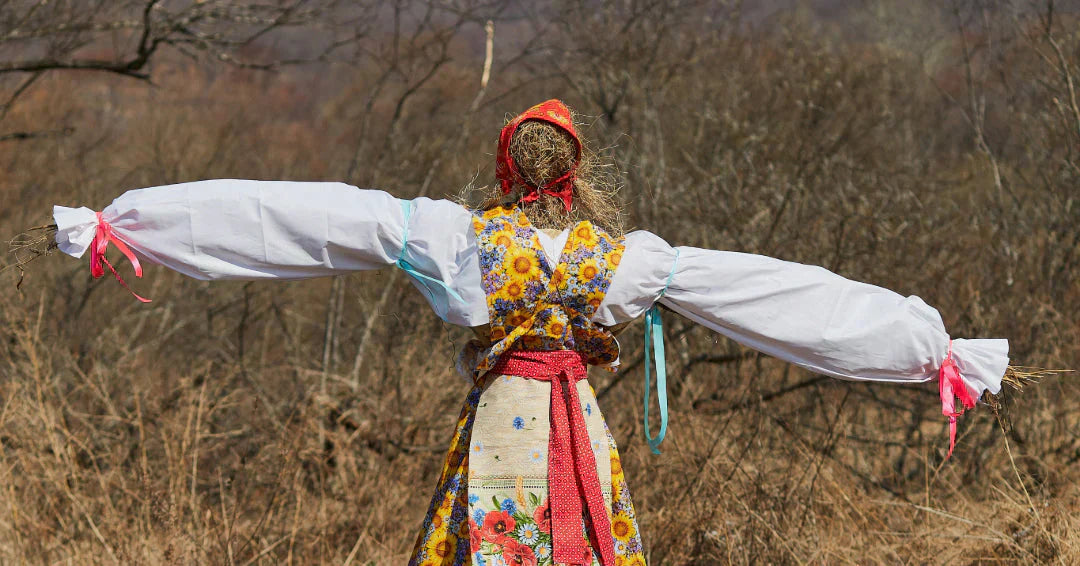Although scarecrows were originally utilized by farmers to keep predators away, these figures have become popular decorations during the autumn months. Stores with seasonal items sell scarecrows with friendly round faces, ready to spruce up the front yard or take a seat on a rocking chair. Of course there are scary varieties with angry expressions, dressed in old, dirty rags indicating a hardened life. Here are some pretty interesting facts about how scarecrows originated and how they have changed over the years.

Scarecrow History, Trivia, Records, Purpose and Other Information
Most kids usually see them perched on front porches alongside pumpkins, witches, cornstalks, blocks of hay, and other Halloween decorations. In children's books about scarecrows, they spring to life, make lots of friends, and wreak a bit of havoc along the way. Only the most discerning little ones may spot one in the middle of a cornfield, doing its best to keep crows from pecking away at the crops. Despite its name, these makeshift statues are designed to keep all sorts of birds, animals and other pests from eating newly planted seeds, fresh shoots sprouting from the ground, and vegetation that is ripe for picking. Believe it or not, scarecrows have quite an interesting history and, perhaps, aren't nearly as effective at doing their job as one may hope. Check out these facts about scarecrows that set the record straight about their purpose in the fields, how effective they are are keeping birds and prey away, and how they have evolved over the years.
Everything to Know About Scarecrows
Kids find scarecrows captivating, and learning facts about them only adds to their intrigue! These friendly figures are deeply connected with fall, harvest season, and Halloween, all exciting times for children filled with traditions, decorations, and treats. Discovering more about scarecrows can deepen their appreciation for these special times of year. Plus, scarecrows are frequently made from everyday items like old clothes and straw, which can spark a child's imagination. Quirky facts—like some early scarecrows smelling bad to keep animals away, or entire villages filled with hundreds of them—can be both surprising and memorable for young minds. Continue reading to learn everything there is to know about these iconic fall decorations!

(1) Scarecrows have been around since 2500 B.C.
The original scarecrows are traced back to Greek farmers. They carved the god of vegetable gardens (Priapus) into wooden structures to keep birds away from the vineyards. Egyptians also built scarecrows to protect the wheat fields along the Nile.
(2) Birds are too smart to be frightened by scarecrows.
It turns out that scarecrows are not very good at their job. Birds quickly learned that these stationary figures were not a threat, so farmers had to find other ways to protect their crops. Windmills and other technology seem to be more effective.
(3) Medieval Britain hired "bird scarers".
Young boys were put to work scaring birds away from the crops. They would run through the fields with large bags of rocks to throw at birds trying to eat the seeds and budding vegetation. After the Great Plague, the population dropped so low and there were not enough boys to help, so farmers began utilizing scarecrows instead.

(4) The most famous scarecrow was introduced in The Wizard of Oz.
The endearing, fictional character epitomizes a scarecrow's lack of purpose and ineffectiveness. The sad sack of hay wants nothing more in life than to have a brain. Audiences quickly felt sorry for this sorry fellow who wasn't the sharpest tool in the shed.
(5) Formidophobia is the fear of scarecrows.
Although the purpose of scarecrows is to frighten birds, some people have developed phobias of these scary figures. People with this phobia suffer negative physical reactions associated with anxiety when crossing paths with a real scarecrow, a decoration, or someone dressed in a scarecrow costume.
(6) Some surmise it's the smell of humans that keeps birds away.
Clever farmers spend hours constructing the biggest, most frightening scarecrows in an attempt to protect their fields from hungry birds and other predators. Some people who have studied the behavior of birds have floated a theory that the structure itself is far less impactful than the odor that clings to the clothing of the scarecrow. Old well-worn dungarees, flannel shirts, and rags carry the smell of people who owned them, and perhaps it is this aroma that keeps the birds at bay.

(7) Scarecrows have a particularly interesting place in Japanese culture.
Dubbed Scarecrow Village, Japan's Ilya Valley is renown for its unique population. Nagoro is an extremely small town, with just 27 residents to be exact, the youngest of whom is over 50 years old. The isolated, senior-friendly town, difficult to reach by train or automobile, manages to attract more than 4,000 tourists annually. And for what reason? Well, the spectacle of a scarecrow population that exceeds humans by a ten to one ratio is the main draw. When Tsukimi Ayano moved to Nagoro, she put her craft skills to work by creating scarecrows to memorialize individuals who passed away. The initial few were installed simply as a means to scare away the birds. But as the town started to shrink (it once boasted 300 residents), she created scarecrows in the likeness of each resident who died.
(8) Joe's Scarecrow Village was a popular tourist attraction for 27 years.
Alongside a busy highway in Novia Scotia, a man by the name of Joe Delaney established an interesting attraction for tourists. What started as a small collection of roadside scarecrows in 1984 grew into a well-known, albeit quirky, place for travelers to take a break and check out a huge displace of scarecrows. By 1989, more than 27,000 visitors had stopped by to check out the collection dressed in a wide variety of costumes, like school kids, celebrities, and politicians. Some were even created to memorialize local prominent people who had passed away. While no fee was charged to walk through the field, visitors were encouraged to drop money in a donation box and visit the souvenir store. When Joe could no longer maintain the site, his son Chester took over until it was permanently closed in 2011.
(9) Europeans associate scarecrows with the supernatural.
As if a decrepit figure in tattered clothing standing solo in a field isn't frightening enough, superstitious farmers in Europe associate scarecrows with the supernatural boogeyman. These monsters, often depicted in ragged shirts and pants, are represented in legends as fearful creatures to avoid at all costs. So when European farmers place scarecrows around their property, they believe these figures will scare away birds as well as anyone or anything else who does not belong.

(10) Frightening movies with scarecrows are for brave viewers only.
The scarecrow, originally designed to keep birds away from crops, has taken on a life of its own. Quite by accident, a haphazardly constructed figure using old rags and clothing has become one of the scariest movie stars in a long list of films spanning over decades. Some of the movies that top the list include: Night of the Scarecrow (1995), Jeepers Creepers (2001), Dark Harvest (1992), Scarecrows (2017), Nightbreed (1990), Scary Stories to Tell in the Dark (2019), Husk (2011), and Children of the Corn III, Urban Harvest (1995).
(11) The tallest scarecrow ever constructed stood over 103 feet tall.
The Guinness Book of World Record was set in 1989 by the Speers family. At the Paris Fall Festival in Ontario, Canada, a team of 15 people built the largest scarecrow, named Stretch II, which proudly measured 103 feet and 6.5 inches.

(12) Historians have learned the original name was "shoy-hoy".
Tracking back to the mid 1500s, farmers referred to figures in their fields as shoy-hoys- a sound that mimics a crow. During this time, they were actual people whose job was to scare crows and other predators who threatened to destroy the crops. Eventually they were replaced by mannequins dressed in crazy, ragged clothing. The term also took on a pejorative meaning, often used to refer to "gaunt or ridiculous" people.







